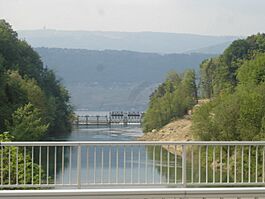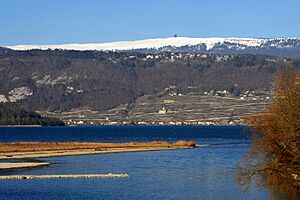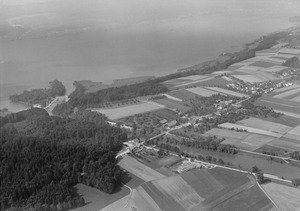Hagneck facts for kids
Quick facts for kids
Hagneck
|
||
|---|---|---|

Hagneck Canal near Hagneck
|
||
|
||
| Country | Switzerland | |
| Canton | Bern | |
| District | Seeland | |
| Area | ||
| • Total | 1.84 km2 (0.71 sq mi) | |
| Elevation | 441 m (1,447 ft) | |
| Population
(Dec 2020 )
|
||
| • Total | 420 | |
| • Density | 228/km2 (591/sq mi) | |
| Postal code |
2575
|
|
| Surrounded by | Ligerz, Lüscherz, Siselen, Täuffelen, Twann, Walperswil | |
Hagneck is a small town, also called a municipality, in Switzerland. It's located in the Bern area, which is like a state, and is part of the Seeland region.
Contents
The Story of Hagneck
Ancient Discoveries in Hagneck
Long ago, people lived in the Hagneck marshland during the Bronze Age. This was a time when people used bronze to make tools. We know this because scientists found signs of old settlements there.
During the Roman era, about 2,000 years ago, a long drainage pipe was built. It was about 200 meters (656 feet) long. Part of an old Roman road can still be seen near the village today. People have also found items from the Middle Ages near the marsh.
How Hagneck Grew Over Time
Hagneck was first mentioned in official papers in 1353. Back then, it was just a tiny village. The land was owned by powerful families, but later, in 1398, the city of Bern took over.
For a long time, Hagneck was very small. In 1783, it was described as just a farm with four houses! But things changed when big projects started.
Between 1873 and 1878, the Jura water correction project built the Hagneck canal. This canal helped drain the wet marshlands nearby. Then, in 1899, the Hagneck power station was built. It used water from a new canal to make electricity. More draining projects happened between 1925 and 1937. These projects turned the marshy land into rich farmland.
Hagneck Today
Hagneck officially became its own municipality in 1840. However, it still shared a school and church with the nearby town of Täuffelen. In 1916, a railroad was built, connecting Hagneck to the rest of Switzerland.
Today, about one-third of the people in Hagneck work in farming, arts and crafts, or at the power plant. The other two-thirds travel to bigger cities like Biel/Bienne and Bern for their jobs.
Hagneck's Location and Land
Hagneck is located on the right side of Lake Biel/Bienne. The Hagneck canal flows into the lake right here. This canal is a very important part of the Jura water correction project, as it helps guide the Aare River into the lake.
Most of Hagneck's land, about 65.6%, is used for farming. About 12.6% of the land is covered by forests. Another 12.6% has buildings and roads. The rest, about 8.2%, is made up of rivers or lakes.
In 2010, Hagneck's old district was changed. It became part of a new, larger district called Verwaltungskreis Seeland.
Hagneck's Coat of Arms
The coat of arms for Hagneck is red with a gold border. It also has a wavy blue stripe going across it.
People of Hagneck
Hagneck has a population of about 417 people (as of December 2011). A small number of people, about 4.5%, are foreign nationals living in Hagneck.
Most people in Hagneck speak German as their main language. A smaller number speak French.
In 2011, about 17.3% of the population were children and teenagers (0–19 years old). Adults (20–64 years old) made up 62.4% of the population, and seniors (over 64 years old) made up 20.4%.
Many people in Hagneck were born in the same area or elsewhere in Switzerland. About 6.7% of the people were born outside of Switzerland.
Here is a chart showing how Hagneck's population has changed over the years:

Cool Places to See
The Hagneck Power Plant (Elektrizitätswerk Hagneck) is a very important historical site. It's recognized as part of the Inventory of Swiss Heritage Sites.
Hagneck's Economy
In 2011, Hagneck had a low unemployment rate of 2.2%. This means most people who wanted jobs had them.
Many people in Hagneck work in different areas:
- Primary Sector: This includes jobs like farming. About 16 people worked in this area.
- Secondary Sector: This includes jobs like manufacturing (making things) and construction. About 13 people worked here.
- Tertiary Sector: This includes jobs in services, like shops, restaurants, or professional services. About 24 people worked in this area.
Most people who live in Hagneck travel to other towns for work. Only about 27 workers (out of 46 total workers in the municipality) both lived and worked in Hagneck. About 21.1% of workers used public transportation, and 53.9% used a private car to get to work.
Religion in Hagneck
Based on a survey from 2000, most people in Hagneck, about 76.2%, belonged to the Swiss Reformed Church. About 10.1% were Roman Catholic. A small number of people belonged to other Christian churches or other religions like Hinduism. About 7.28% of the population did not belong to any church.
Education in Hagneck
Many adults in Hagneck have a good education. About 66.3% have finished upper secondary education, which is like high school. About 14.1% have gone on to higher education, like university.
In 2000, only 1 student lived in Hagneck and went to school there. Most students, about 53 of them, traveled to schools outside of Hagneck.
See also
 In Spanish: Hagneck para niños
In Spanish: Hagneck para niños








